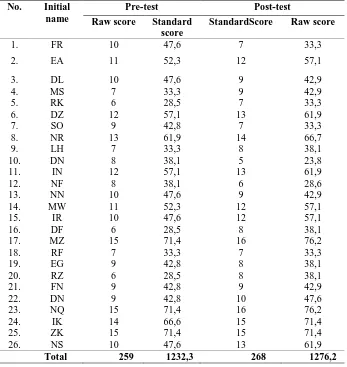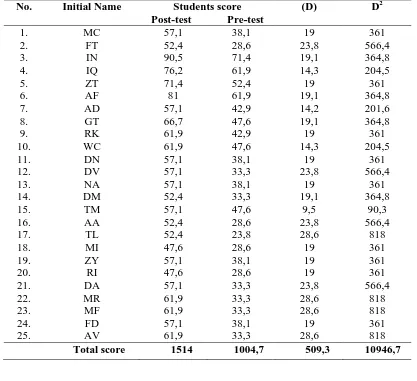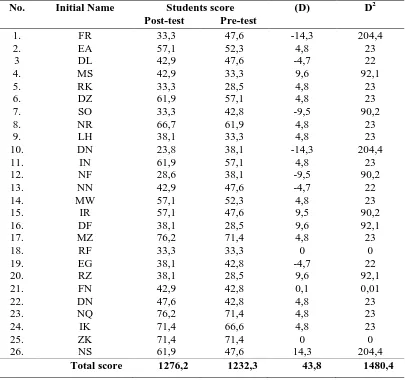e-Journal of English Language Teaching Society (ELTS) Vol. 4 No. 1 2016 – ISSN 2331-1841 Page 1
IMPROVING LISTENING
COMPREHENSION SKILLS OF THE
SECOND YEAR STUDENTS THROUGH
AUDIO
–
LINGUAL METHOD
Meti Sri Astuti1, Mochtar Marhum2, Erniwati3
Abstract
This research aims to find out whether the use of Audio-lingual Method can improve listening comprehension skills of the second year students of Madrasah Tsanawiyah Negeri Taipa. The research samples were VIII B as the experimental group which consisted of 26 students and VIII A as the control group which consisted of 25 students selected by cluster sampling technique. The instrument of data collection was a test which was given as pre-test and post-test. The data were analyzed statistically in order to find out the significance of the achievement of the students in pre-test (40.1) and post-test (60.5). The researcher used 0.05 level of significant with 49 degrees of freedom (d.f. 26+25-2 = 49). After analyzing statistically, the researcher found that the result of t-counted was (12.8) higher than t-table (2.00). It means that the use of Audio-lingual Method can improve listening comprehension skills of second year students Madrasah Tsanawiyah Negeri Taipa.
Keywords: Listening, Comprehension, Audio-Lingual Method.
INTRODUCTION
Listening, one of the most important aspects of effective communication, is an
active process of receiving and responding to spoken (explicit) or unspoken (implicit)
message from the speaker. When someone listens to a speaker, he has to understand both
the words (the information being communicated) and the speaker feels about what they are
communicating. Therefore, a good listening ability is required to support oral
communication.
Listening is the language modality that is used most frequently. Listening becomes
the main activity in learning a language because most of the time in language class is used
for listening to teacher and friends. It looks like simply but, there are many processes
interacting with the actually sounds received by a listener. Understanding these different
e-Journal of English Language Teaching Society (ELTS) Vol. 4 No. 1 2016 – ISSN 2331-1841 Page 2
understand how to teach listening to students. However, some students may get difficulty in
listening; therefore, they are bored and not interested in the subject.
When the researcher interviewed the English teacher of Madrasah Tsanawiyah
Negeri Taipa, she found two main problems faced by students. First, most of the students
did not have motivation and not interested in materials or topics on listening. As a result,
they were not keen to learn English and that, highly influenced their learning achievement.
To solve the problem, English teachers have to find a suitable method and technique that
can motivate students to learn English especially listening comprehension skills. This
statement is highly supported by Richards and Rodgers (1987:4), that teachers must provide varieties of drills and tasks to keep learner’s motivation. Were drills is one of techniques in Audio-Lingual Method. For example, by applying drill in the classroom, teacher can
represent real communication as the technique offers pronunciation, vocabulary, and
grammar practice. It motivates students to become active listeners and therefore,
comprehension skills can easily be improved. Second, students could not analyze the sound.
Consequently, they failed in understanding what the teacher said. In order to make students
understand what the speaker or teacher means, they need to practice repeating an idea
frequently to remember it, so the students can be improved their listening skill. Were
repetition is one of techniques in Audio-Lingual Method. This statement is highly supported
by Philip Smith (1965: 11) argue that “audio-lingual method were effective to teach listening comprehension for learner’s language”. For that reason, the researcher used Audio-Lingual Method, which is believe to be able to help students be an active listener.
The Audio-Lingual method teaches language through dialogues that focus on habit
formation of students. It has purpose to develop communicative competence of students through dialogues. “Dialogues and pattern drills that students need to repeat are used to form habits in learners that will allow them to develop quick and automatic responses.
Drills are useful in foreign language teaching in which they give students the opportunity to perform what they have learned” (Mart, 2013,p.63).
METHODOLOGY
To conduct her research, the researcher applied one of the three types of quasi-experimental
research design called the non-equivalent control group design. There were two groups
involved; experimental and control group. The researcher taught both groups. She taught the
e-Journal of English Language Teaching Society (ELTS) Vol. 4 No. 1 2016 – ISSN 2331-1841 Page 3
using regular instruction or without specific teaching method; she played the audio, asked
students to answer the questions while listening to the audio. Both groups was pre-tested
and post-tested, but treatment was given to the experimental group only. The following
formula is the research design as suggested by Cohen (2007:302).
Experimental 01 X 02
Control 03 04
Where:
01 & 03 = pre-test 02 & 04 = post- test
X = treatment
Population is a group of people and things which are going to be investigated.
According to Fraenkel, et.al (2012:91). Population of this research was the second year
students of Madrasah Tsanawiyah Negeri Taipa, which consisted of four parallel classes:
VIII A, VIII B, VIIIC and VIIID. Each class consisted of 25-26 students; therefore, total
population was 102.
Fraenkel, et al (2012:91) explain, “A sample in a research study is the group on which information is obtained.” The sample was chosen using cluster sampling technique. The researcher provided three pieces of paper with the name of the class and put them into a
box. Next, she took out two pieces of paper. The first paper grasped was the experimental
class (VIII B) and the second was the control class (VIII A). There were two variables in
this research, they were independent and dependent variable. The independent variable was
the implementation of Audio-Lingual Method in teaching listening comprehension skills,
while the dependent variable was the students listening comprehension skills. In conducting
the research, the researcher used pre-test and post-test as a test. They were 8 items of
completion/fill-in-the blank and 5 items of multiple choice test. The following is the scoring
e-Journal of English Language Teaching Society (ELTS) Vol. 4 No. 1 2016 – ISSN 2331-1841 Page 4
class using Audio-Lingual Method. The treatment was conducted 8 times excluding the
pre-test and the post-pre-test. Therefore, to determine the students individual score on pre-pre-test and
post-test, the researcher used a formula proposed by Arikunto (2006:240) as follows:
∑
post-test, the researcher applied the following formula by Hatch & Farhady (1982:55) :
∑
e-Journal of English Language Teaching Society (ELTS) Vol. 4 No. 1 2016 – ISSN 2331-1841 Page 5
S = √∑
∑
Where :
S = standard deviation of differences
∑
= sum of deviation scoresN = total number of students
After getting the standard deviation of each group, the reseacher continued to
tally the standard error of differences using a formula by Hatch & Farhady (1982:105) as
seen below.
SD = √( ) ( )
Where :
SD = standard error of differences
S1 = standard deviation of experimental group S2 = standard deviation of the control group
= number of students in control group
Last, in order to know whether or not the treatment was effective, the researcher
used the formula proposed by Hatch & Farhady (1982:105). The formula can be represented
as below.
Where :
t = oserved t value
= mean of deviation scores of experimental group
standard error of difference
The criterion of testing hypothesis are that if the tcounted is higher than t table, it means
that the hyphothesis of this research is accepted. In other words, there is a significant
correlation between the two variables. However, if tcounted is lower than ttable, it means the
e-Journal of English Language Teaching Society (ELTS) Vol. 4 No. 1 2016 – ISSN 2331-1841 Page 6 FINDINGS
In conducting this research the researcher use pre-test and post-test to collecting
data. The result of pre-test was to test the prior ability of the students in listening
comprehension skills. The result post-test was to measure the students progress after
receiving treatment and the effectiveness of Audio-Lingual Method in improving listening
comprehension skills. The result of the pre-test can be seen in the table below.
Table 2
The Pre-test and Post-test Scores of the Experimental Group
e-Journal of English Language Teaching Society (ELTS) Vol. 4 No. 1 2016 – ISSN 2331-1841 Page 7 Table 3
The Pre-test and Post-test Scores of the Control Group
No. Initial
Therefore, the mean score of the experimental group was 40.1, while the mean score
of the control group was 47.3. By 7.2 mean score difference, it can be argue that level of
knowledge of both groups before treatment was nearly equal. Having conducted treatment
to the experimental group, the researcher administered post-test to both groups to measure
e-Journal of English Language Teaching Society (ELTS) Vol. 4 No. 1 2016 – ISSN 2331-1841 Page 8
skills on October 1th, 2015. The researcher calculated the means score of the experimental
group and control group on the post-test as follows.
∑
∑
So, the mean score of the experimental group was 60.5, and the control group was
49. When the mean score of both groups compared, it was found that the differences was
10.6. In other words, the treatment given was effective. After getting the mean score of both
groups, the researcher continued to count groups deviation (D), followed by the degree of
score difference which is symbolized by (D2) as shown in table below.
Table 4
Score Difference of experimental group on Pre-test and post-test
e-Journal of English Language Teaching Society (ELTS) Vol. 4 No. 1 2016 – ISSN 2331-1841 Page 9 Table 5
Score Difference of control group on Pre-test and post-test
No. Initial Name Students score
experimental group was 20.3, whilst the mean deviation of the control group was 1.6. After
that, the researcher finding out the standard deviation of both groups. Thus, the standard
deviation of the experimental group was 4.42, and the standard deviation of the control
group 7.49. After having the standard deviation of both groups, the researcher calculated the
standard error of differences. The computation above showed that the standard error of
differences of experimental groups was 1.45.
To know whether the use of Audio-Lingual Method was effective to improve students
listening comprehension skills of the second year students of MTS Negeri Taipa, the
researcher restated the criterion of testing hypothesis that if t-counted is greater than t-table
the hypothesis is accepted, but if t-counted is lower than t-table the hypothesis is rejected.
e-Journal of English Language Teaching Society (ELTS) Vol. 4 No. 1 2016 – ISSN 2331-1841 Page 10
accepted because the observed t-counted (12.8) was greater than the critical t-table (2.00). It
means that the use of Audio-Lingual Method can improve students listening comprehension
skills of the second year of MTS Negeri Taipa.
DISCUSSION
The objective of this research was to prove whether or not the use of Audio-Lingual
Method can improve listening comprehension skills of the second year students of
Madrasah Negeri Taipa. The researcher limited her scope of research on two micro-skills of
listening skills; the ability to recognize vocabulary used in core conversational topics and
the ability to deduce meaning of words from context.
At the first step, the researcher was given pre-test on September 2th, 2015. After
carring out the pre-test, the researcher gave treatment to the experimental class using
Audio-Lingual Method. The treatment was conducted 8 times excluding the pre-test and the
post-test. After giving treatment to experimental group, the researcher gave a post-test to both
groups on October 1th, 2015. The test was to measure the students progress after receiving
treatment and the effectiveness of Audio-Lingual Method in improving listening
comprehension skills.
To measure the prior ability of the students in listening to the above micro-skills, the
researcher conducted a pretest which consisted of thirteen items; 8 items of
completion/fill-in-the blank and 5 items of multiple choice. Based on the criteria above it was found that
only one students of the experimental group got good score on the pretest. 2 students got
fair score, 6 students got bad score, and 16 students or 64% of the total student of
experimental group got very bad score. Meanwhile, the students score of the control group
showed that 3 students got good score, 4 students got fair score, 11 students got bad score
and 8 students or 30.8% of the total student of control group got very bad score. On seeing
number of students who got good and fair score, it can be said that the students’ ability of
both groups was nearly equal.
Yet, having received treatment for eight times, the score of the experimental group
students significantly improved on the post-test. Based on the pre-test there were only three
students (12%) categorized pass, it rose by 64% on the post-test. The passing became 19
students. In contrast, the passing students of the control group increased 15.4%, from 7
students on the pre-test to be 11 students on the post-test. This statement is highly supported
e-Journal of English Language Teaching Society (ELTS) Vol. 4 No. 1 2016 – ISSN 2331-1841 Page 11
showed that t-counted value (12.8) was higher than t-table (2.00). Thus, using
Audio-Lingual Method can improve listening comprehension skills of the second year students of
MTS Negeri Taipa.
CONCLUSIONS AND SUGGESTIONS
Based on the data presented on previous discussion, By selecting 0.05 level of
significances with 49 degrees of freedom as the indicators, the researcher got the value of
the observed t-value was 12.8 and the value of the critical t-table was 2.00. It means that the
research hypothesis is accepted because the observed value was higher than the critical
t-table. Thus, the researcher concludes that Audio-Lingual Method is quite effective in
improving students listening comprehension skills of the second year students of Madrasah
Tsanawiyah Negeri Taipa. This method promotes a lively classroom environment, which
support students to be an active listener.
In relation to the conclusion above, the researcher would like to offer some
suggestions to teacher of english. They should be more creative in teaching so the students
will be more interested in learning, especially listening skills. They also should apply
Audio-Lingual Method particularly the drills and pattern practice to help students be an active
listener.
REFERENCES
Arikunto, S. (2006). Prosedur Penelitian: Suatu Pendekatan Praktek. (Edisi Revisi VI). Jakarta: Asdi Mahasatya.
Cohen, L., Manion, L., & Morrison, K. (2007). Research Methods in Education. London: Routledge/ Falmer.
Fraenkel, J. R., Wallen, N. E., & Hyun, H. H. (2012).How to Design and Evaluate Research in Education. New York: McGraw- Hill.
Hatch, E & Farhady, H. (1982). Research design and statistic for applied linguistics.
Rowley: Newbury House Publiser inc.
Mart, C.T. (2013). The Audio-Lingual method: An Easy Way of Achieving Speech.
International Journal of Academic Research in Business and Social Sciences, Vol.3, p.63-65.
Richards, J.C & Rodgers, T.S. (1987). The Audio-Lingual Method: Approaches and
Methods in language teaching. Reino Unida: Cambridge University Press.


